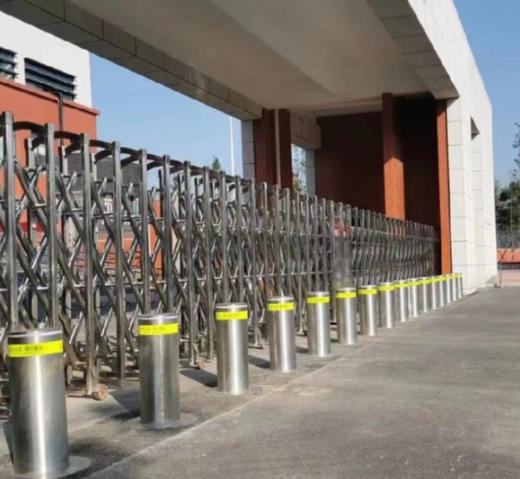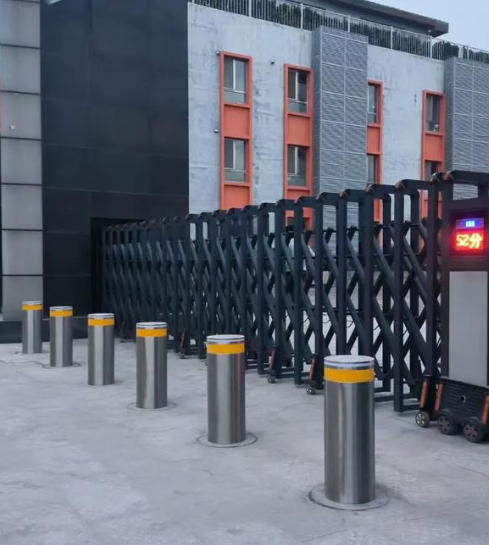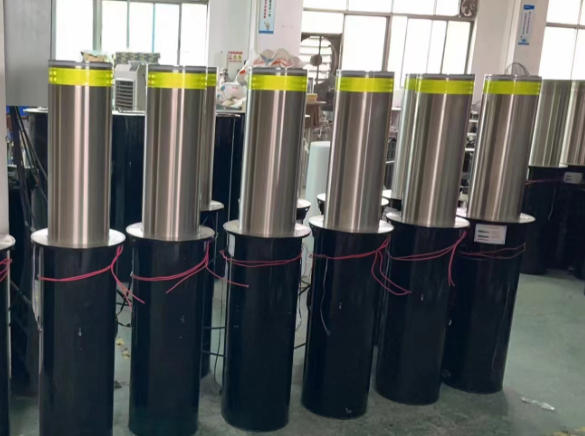Enhancing Urban Safety and Access Control with Automatic Rising Bollards: A Modern Solution for Vehicle Management and Perimeter Security
Introduction: The Growing Demand for Smarter Vehicle Access Control
In today’s urban landscape, security threats and unauthorized vehicle access are becoming more frequent concerns. Whether it’s protecting pedestrians in crowded public spaces or controlling vehicular access to restricted zones, urban infrastructure requires intelligent, automated solutions. One of the most effective and increasingly adopted systems is the Automatic Rising Bollard—also known as an Automatic Retractable Bollard, Telescopic Bollard, or Automatic Vehicle Barrier Post.
These robust, vertical posts rise from the ground automatically to control or block vehicle access, and retract when passage is allowed. From city centers and business parks to military facilities and residential communities, automatic bollard systems are rapidly becoming a cornerstone of modern traffic management and perimeter security.
What Is an Automatic Rising Bollard?
An automatic rising bollard is a ground-mounted security post that automatically elevates and lowers based on access permissions. Designed for vehicle access control, it ensures secure entry and exit in sensitive zones. These bollards are typically constructed of hardened stainless steel, carbon steel, or aluminum, and are powered by hydraulic, electric, or pneumatic mechanisms.
Key Features:
- Remote access control (RFID, keypad, ANPR systems)
- Crash-rated strength (up to K12 or PAS 68 standards)
- Weatherproof housing (sealed bollard systems)
- Integrated lighting and alarms
- Emergency manual override
Popular types include:
- Hydraulic automatic rising bollards
- Electric automatic bollards
- Pneumatic telescopic bollards
- Removable and semi-automatic bollards (for lower-traffic areas)

Why Install Automatic Retractable Bollards?
1. Prevent Unauthorized Vehicle Access
Automatic retractable bollards physically prevent vehicles from entering restricted zones. This is essential for:
- Government buildings
- Military bases
- Airports and embassies
- Pedestrian plazas and bike lanes
- VIP residences and gated communities
- Schools and University
2. Mitigate Vehicle-Ramming Attacks
In recent years, vehicle-borne threats have increased in frequency, with incidents involving cars or trucks being used to cause harm. Crash-rated rising bollards are engineered to stop a moving vehicle dead in its tracks—protecting pedestrians and infrastructure.
3. Enhance Urban Aesthetics
Unlike large barriers or gates, bollards retract flush with the ground when not in use, preserving the look and flow of the environment—ideal for hotels, historical landmarks, and commercial zones.
4. Automated and Remote Access
Integrated with smart access control systems, rising bollards can be operated remotely or automatically triggered via license plate recognition (ANPR), RFID cards, or mobile apps.
Risks of Not Using Automatic Bollard Systems:
Failing to install automatic vehicle bollards in critical entry points can lead to:
- Security breaches
- Unauthorized deliveries or parking
- Accidents at pedestrian crossings
- Uncontrolled traffic flow
- Exposure to terrorist vehicle threats
- High insurance premiums due to security gaps
Many high-profile institutions have learned the hard way after suffering physical and reputational damage due to inadequate vehicle control systems.
Key Applications of Telescopic Bollards:
Automatic telescopic bollards are widely used in:
- Urban Planning and Smart Cities
- Control traffic flow in city centers
- Restrict access during events or rush hours
- Corporate and Industrial Facilities
- Protect sensitive areas from unapproved vehicle access
- Secure parking areas for staff and VIPs
- Residential and Gated Communities
- Improve neighborhood safety
- Prevent outsiders from using private roads
- Public Venues
- Stadiums, arenas, tourist hotspots
- Manage crowd movement and prevent threats
- Infrastructure Protection
- Airports, data centers, utilities
- Prevent high-speed vehicle attacks
Technical Overview and Installation Considerations:
1. Material and Build Quality
Most bollards are made from Q235 carbon steel, 304/316 stainless steel, or galvanized steel, and finished with powder coatings to resist rust and corrosion.
2. Control Systems
- PLC programmable logic controllers
- Remote control units
- Loop detectors and proximity sensors
- Emergency manual pumps
3. Power Systems
- Hydraulic Rising Bollards: Smooth, powerful, ideal for heavy-duty applications.
- Electric Bollards: Quiet operation and energy efficient.
- Pneumatic Systems: Cost-effective and fast.
4. Installation Requirements
- Ground depth for the base (typically 1100–1500mm)
- Drainage and sealing systems (especially in rainy or flood-prone areas)
- Dedicated control cabinet
- Power supply and emergency battery backup
Smart Integration and Automation:
Today’s smart bollard systems integrate with:
- License Plate Recognition (LPR/ANPR)
- Building security systems
- Parking management software
- Mobile app controls
- Cloud-based remote monitoring
This allows seamless automation, data tracking, and remote diagnostics—ideal for smart cities and IoT-integrated infrastructures.
Maintenance and Durability:
A properly manufactured and installed automatic rising bollard system can last over 10 years with minimal maintenance. Key recommendations:
- Perform monthly system checks (motor, pump, control board)
- Clean and lubricate the column regularly
- Replace worn hydraulic oil every 1–2 years
- Check for waterproof seal integrity
Many advanced systems feature self-lubricating cylinders and anti-collision memory resets to minimize downtime.
Global Market Trends and Growing Demand:
The global market for automatic bollard systems is projected to grow substantially due to increasing security concerns and urban development initiatives. Key drivers include:
- Government mandates on urban security
- Smart city infrastructure projects
- Rising threat of vehicle-based attacks
- Increased demand for traffic control automation
Regions like Europe, the Middle East, and Asia-Pacific are showing rising adoption, especially in:
- Public sector tenders
- Airport and railway safety projects
- Smart parking systems
Comparison with Other Access Control Systems:
|
Feature |
Rising Bollards |
Swing Gates |
|
Boom Barriers |
Fixed Posts |
|
Aesthetic |
✅ |
❌ |
|
❌ |
✅ |
|
Crash Protection |
✅✅✅ |
❌ |
|
❌ |
✅ |
|
Automation |
✅ |
✅ |
|
✅ |
❌ |
|
Emergency Access |
✅ |
✅ |
|
✅ |
❌ |
|
Pedestrian Friendly |
✅ |
❌ |
|
❌ |
✅ |
|
Maintenance |
Low |
Medium |
|
Medium |
Very Low |
Rising bollards strike the ideal balance between security, aesthetics, and automation, making them the superior choice in many cases.

Why Rising Bollards Are a Must-Have in Modern Urban Planning?
In an age where urban security and automated traffic control are no longer optional, automatic retractable bollards present a compelling solution. Whether your goal is to protect lives, regulate vehicle access, or enhance the appearance of your facility, rising bollards offer:
- High performance
- Seamless integration
- Long-term durability
- Scalable control systems
Cities, developers, government agencies, and commercial properties worldwide are realizing the long-term cost-effectiveness and protective power of these automated access barriers.
Real-World Case Studies — Success Stories of Rising Bollard Installations
To highlight the effectiveness of automatic retractable bollards, let’s look at successful implementations across different sectors:
1. City Center Pedestrianization – Amsterdam, Netherlands
Amsterdam installed over 100 automatic rising bollards to enforce pedestrian-only zones during daytime hours. These bollards have successfully reduced traffic accidents, improved air quality, and increased foot traffic for local businesses.
2. Airport Security Reinforcement – Dubai International Airport
Due to increased global threats, Dubai Airport reinforced entry and exit gates with crash-rated hydraulic bollards that can stop a 7.5-ton truck traveling at 80 km/h. These bollards are integrated with license plate recognition (LPR) and emergency override systems.
3. University Campus Access – Sydney, Australia
A large university in Sydney implemented telescopic bollards to manage vehicle access to campus. Integration with RFID student IDs allows seamless entry for faculty and maintenance staff, while unauthorized vehicles are automatically denied entry.
4. Corporate Headquarters Protection – Frankfurt, Germany
A financial firm used electric retractable bollards at its headquarters to secure underground parking and manage VIP access. This created a smooth traffic flow without compromising security.
5. Tourist Site Conservation – Kyoto, Japan
Historic areas in Kyoto installed bollards that operate only during specific hours to prevent vehicle damage to ancient streets and to preserve ambiance. These bollards are both functional and aesthetically designed to blend with traditional surroundings.

Work With a Trusted Manufacturer — Made in China, Delivered Worldwide
Securina as a leading professional manufacturer of automatic rising bollards based in China, with over 10 years of experience in security and traffic control system development.
Our product range includes:
- Hydraulic automatic bollards
- Electric retractable bollards
- Smart bollard systems with LPR
- Crash-rated PAS 68/K12 bollards
- Customized solutions for OEM and global distribution
-- Competitive Pricing
-- OEM/ODM Service
-- Global Shipping
--24/7 Technical Support
Whether you’re a city planner, security contractor, or distributor, we welcome you to contact us directly for catalogs, specifications, and pricing. We’re eager to help you secure your premises with our reliable and advanced bollard systems. Let us help you build a smarter, safer, and more secure environment with our advanced bollard technology.